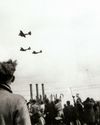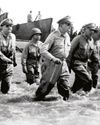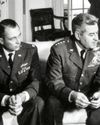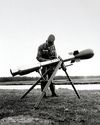
In September 1946, the British military government of occupied Germany, and its Soviet opposite number, signed an agreement formalising a military liaison between the two newly neighbouring powers. The idea was to create a communications channel to resolve disputes or misunderstandings which could lead to, at best, a diplomatic incident – at worst, a military confrontation. ‘Liaison’ created a pathway for the discussion of issues and resolution of disputes before they escalated out of control. The agreement, which became known as the Robertson-Malinin Agreement (RMA), created reciprocal missions in the British and Soviet zones, accredited to the respective commander-in-chief, and remained in place, unaltered, until German reunification.
The British Mission was called the British Commanders’in-Chief Mission to the Soviet Forces of Occupation in Germany – BRIXMIS, BRX, or to those who served in it, the Mission. The Soviet equivalent in the British zone of West Germany was known as SOXMIS, and similar agreements were made in 1947 with the Americans and the French, creating the US Military Liaison Mission (USMLM) and the Mission Militaire Française de Liaison (MMFL). Together with BRIXMIS, they formed the Allied Military Liaison Missions (AMLMs).
The Mission had two headquarters: a forward HQ in Potsdam, the Mission House, inside the Soviet Zone (later the German Democratic Republic); and a rear HQ, located at the Olympic Stadium in West Berlin. The only way Mission personnel could cross from West to East was via the Glienicke Bridge (the ‘Bridge of Spies’), running the gauntlet of Soviet guards and closely watched by the East German secret police, the infamous Stasi. Their opposite number in Potsdam was the Soviet External Relations Branch (SERB), staffed mainly by GRU and KGB officers.
Denne historien er fra Issue 136-utgaven av History of War.
Start din 7-dagers gratis prøveperiode på Magzter GOLD for å få tilgang til tusenvis av utvalgte premiumhistorier og 9000+ magasiner og aviser.
Allerede abonnent ? Logg på
Denne historien er fra Issue 136-utgaven av History of War.
Start din 7-dagers gratis prøveperiode på Magzter GOLD for å få tilgang til tusenvis av utvalgte premiumhistorier og 9000+ magasiner og aviser.
Allerede abonnent? Logg på

NAUMACHIA TRUTH BEHIND ROME'S GLADIATOR SEA BATTLES
In their quest for evermore novel and bloody entertainment, the Romans staged enormous naval fights on artificial lakes

OPERATION MANNA
In late April 1945, millions of Dutch civilians were starving as Nazi retribution for the failed Operation Market Garden cut off supplies. eet as In response, Allied bombers launched a risky mission to air-drop food

GASSING HITLER
Just a month before the end of WWI, the future Fuhrer was blinded by a British shell and invalided away from the frontline. Over a century later, has the artillery brigade that launched the fateful attack finally been identified?

SALAMANCA
After years of largely defensive campaigning, Lieutenant General Arthur Wellesley went on the offensive against a French invasion of Andalusia

HUMBERT 'ROCKY'VERSACE
Early in the Vietnam War, a dedicated US Special Forces officer defied his merciless Viet Cong captors and inspired his fellow POWs to survive

LEYTE 1944 SINKING THE RISING SUN
One of the more difficult island campaigns in WWII's Pacific Theatre saw a brutal months-long fight that exhausted Japan’s military strength

MAD DAWN
How technology transformed strategic thinking and military doctrine from the Cold War to the current day

BRUSHES WITH ARMAGEDDON
Humanity came close to self-annihilation with the Cuban Missile Crisis, Broken Arrows’ and other nuclear near misses

THE DEADLY RACE
How the road to peace led to an arms contest between the USA and USSR, with prototypes, proliferation and the world’s biggest bomb

THE MANHATTAN PROJECT
Einstein, Oppenheimer and the race to beat Hitler to the bomb. How a science project in the desert helped win a war